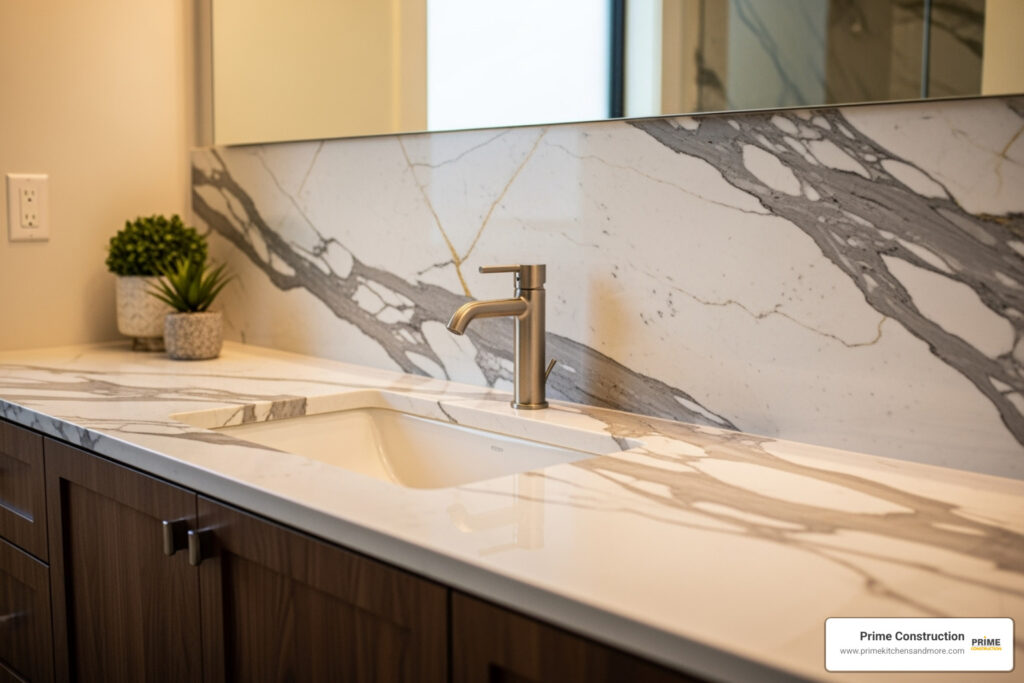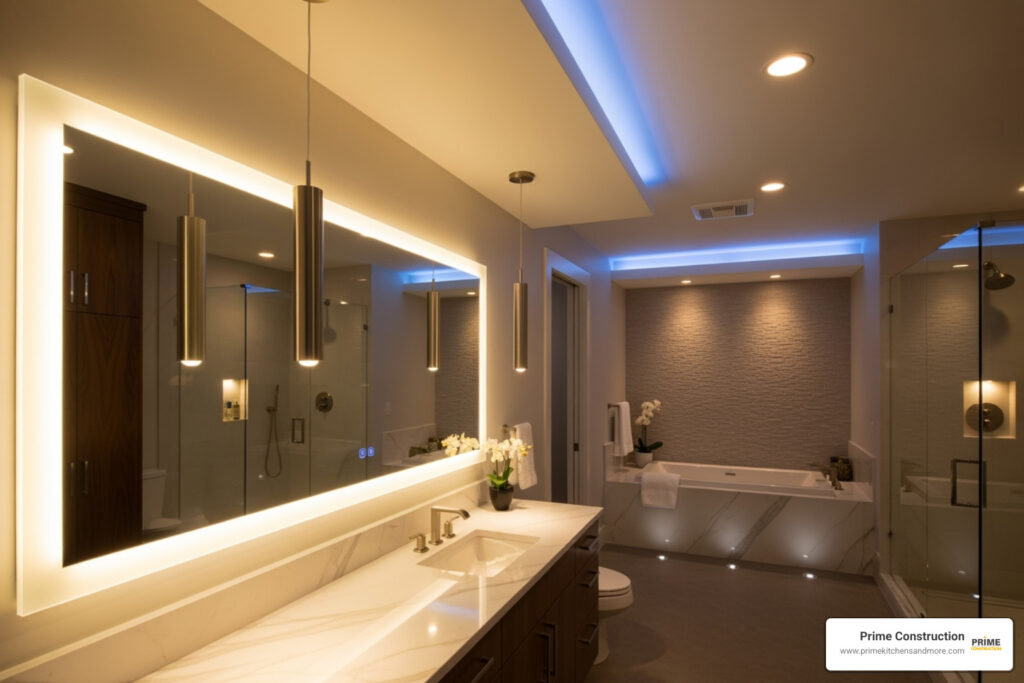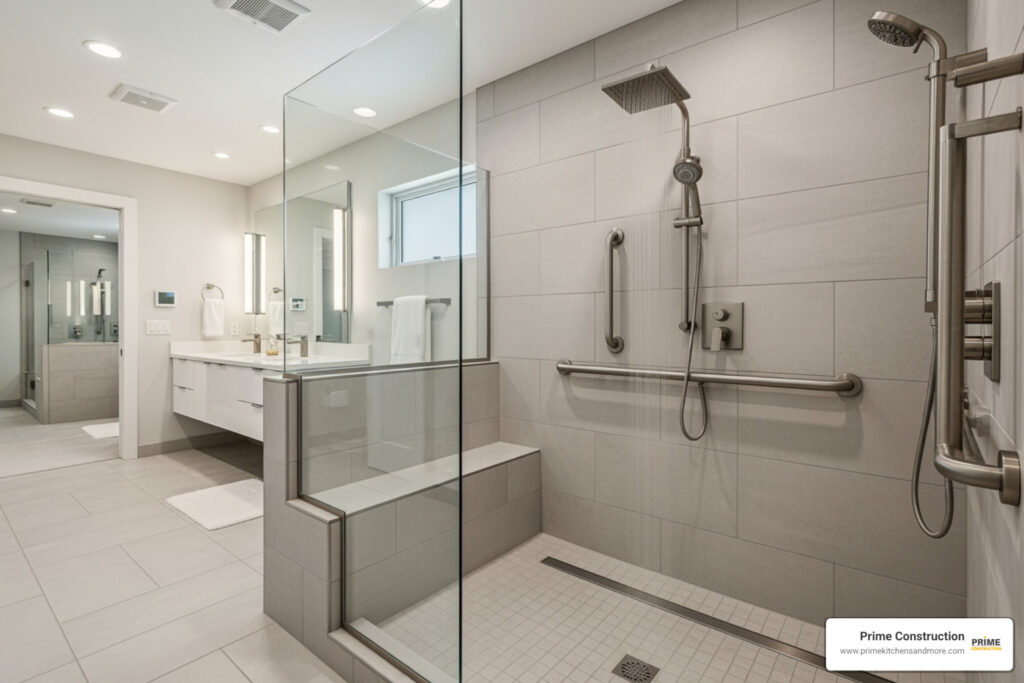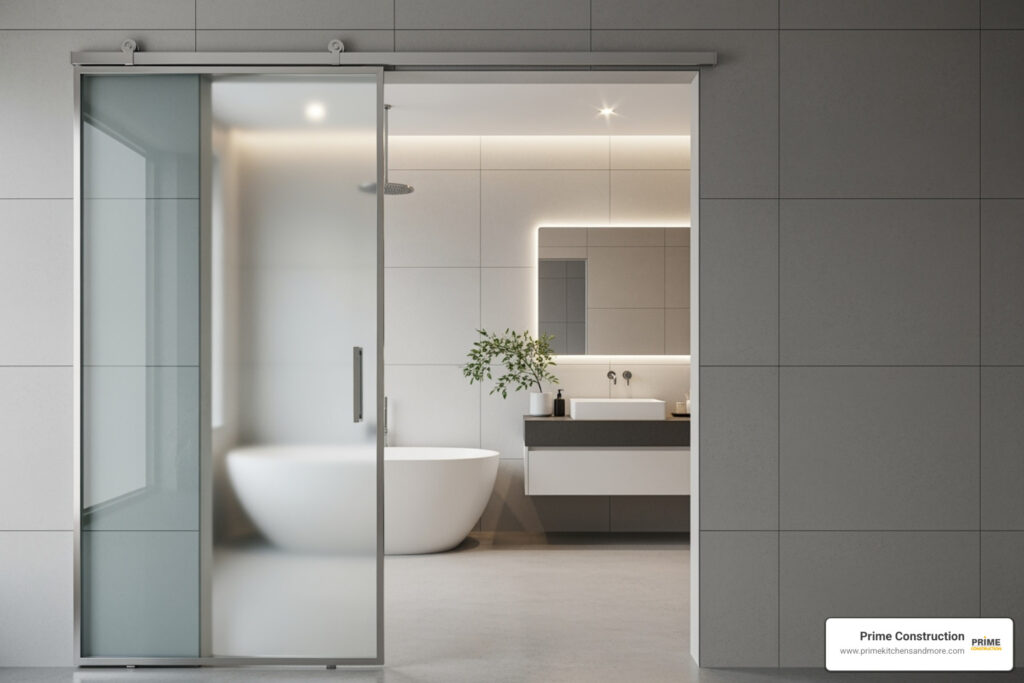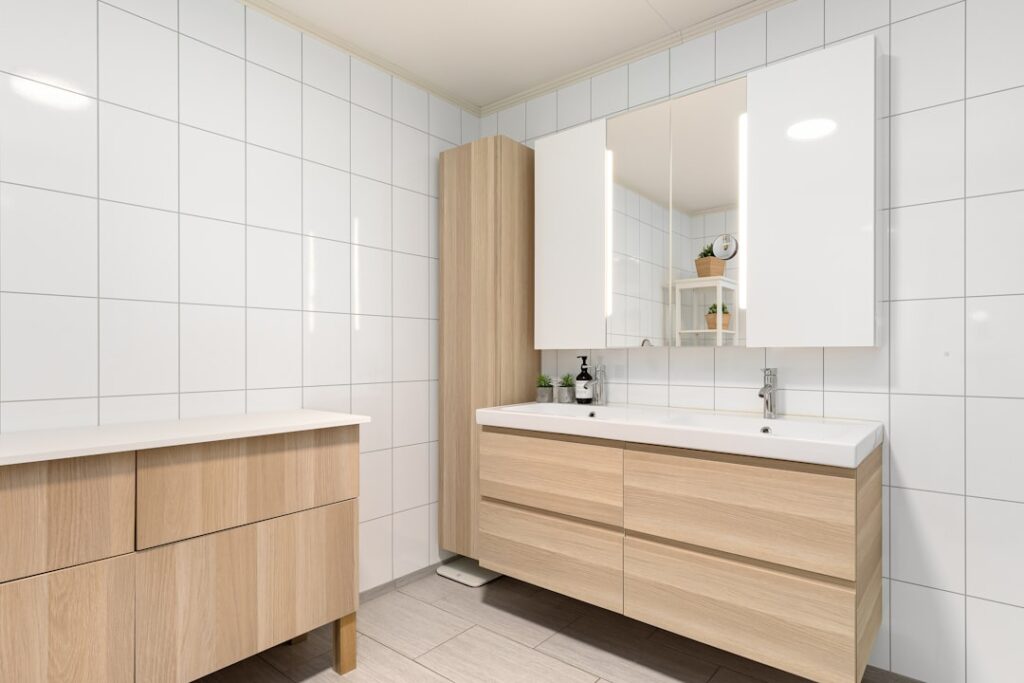Why Small Bathrooms Need Heated Floors Most
Aheated floor small bathroomtransforms your coldest morning moments into spa-like comfort. Here’s what you need to know:
Quick Benefits:
- Warmth: No more cold tile shock on winter mornings
- Energy savings: 15-20% more efficient than forced air heating
- Cost: $175-$700 for materials in a typical 35-50 sq ft bathroom
- Installation: Electric mats are DIY-friendly, cables need professional wiring
- Operating cost: Just $0.03-$0.05 per hour to run
Nobody likes stepping onto freezing bathroom tiles at 6 AM.Heated floors work better in small spaces than large ones.Your compact bathroom heats up faster, costs less to install, and gives you maximum comfort return on every dollar spent.
Electric radiant systems are surprisingly affordable – starting around $5-$12 per square foot installed. For a typical 35 square foot heated area, you’re looking at $175-$420 in materials plus installation costs.
The real win?Twenty percent of home buyers specifically want heated floors. It’s a luxury feature that pays for itself in comfortandresale value.

Basicheated floor small bathroomvocab:
Why Radiant Heat Rocks in Tiny Baths
When you’re working with a compact bathroom, every upgrade needs to earn its keep.Heated floor small bathroomsystems don’t just earn their keep – they become the star of your morning routine.
The comfort factor is real.Your feet have more nerve endings than almost any other part of your body. When they’re warm, your whole body feels warmer. That’s why you can actually set your thermostat 2-3 degrees lower with radiant heat and still feel more comfortable.
Energy efficiency becomes your friendin small spaces. Electric radiant systems convert up to 99% of electricity directly into heat – no energy lost through ductwork. In a typical small bathroom, you’re looking at about 25 cents per day to keep those tiles toasty warm.
Resale value matters.One in five buyers specifically wants radiant floor heating when they’re house hunting. In Orlando’s competitive market, that luxury feel can make your home stand out without breaking the bank.
Your air quality improves too.Unlike forced air systems that blow dust around your bathroom, radiant heat rises gently from the floor. No dry air blasting, no circulation of bathroom moisture, just clean warmth.
Even heat distributionsolves the classic small bathroom problem – those annoying cold spots near the toilet or scorching hot zones right under the wall heater. Radiant systems warm your entire floor surface evenly.
Main Benefits at a Glance
Warm toes every single morning– Most electric radiant systems heat up in 20-60 minutes. Program your thermostat to start warming 30 minutes before your alarm goes off.
Silent operationthat actually stays silent. Zero noise. No fan motors humming, no ductwork expanding, no mysterious clicking sounds at 3 AM.
Low maintenancethat stays low maintenance. Once installed, electric radiant floors require virtually no upkeep. No filters to remember, no moving parts to break down.
Pros & Cons Snapshot
The luxury feel advantagesare compelling. You’re changing cold tiles into warm surfaces that make your bathroom feel like a spa retreat. These systems work with practically any flooring material and might eliminate the need for other heat sources.
Energy costs actually dropcompared to forced air systems, and you’re looking at a 25+ year lifespan with minimal maintenance.
The reality check drawbacksdeserve consideration. Higher upfront installation costs, plus you’ll need about 1/4 to 1/2 inch of floor height increase. Professional electrical work is required, and if heating elements fail, repair means removing flooring.
Some flooring types won’t work – thick carpets and certain laminates are out. Radiant systems also have slower response times than forced air.

Best Systems for aHeated Floor Small Bathroom
For small bathrooms, electric systems almost always win over hydronic (water-based) systems. Here’s why:
Electric Systems: The Small Bathroom Champion
Electric radiant heating uses resistance cables or mats that convert electricity directly into heat. They’re perfect for small spaces because they don’t require boilers, pumps, or complex plumbing connections.
Smart Thermostat Integration
Modern systems come with programmable thermostats controlled via smartphone apps. Set your bathroom to warm up before your morning routine, then automatically reduce temperature when you’re at work.
Watt Density Matters
For bathrooms, look for systems that provide 12-15 watts per square foot. This gives you enough heat output to warm the room, not just take the chill off the floor.
Electric Mats vs Cables – Which Wins?
Electric Mats: The DIY Darling
Pre-spaced heating cables attached to mesh backing make installation straightforward. You roll them out like carpet, connect the wires, and you’re done.
Pros:
- Quick installation (often same day)
- Consistent 3-inch cable spacing
- Less chance of installation errors
- Good for DIY-friendly homeowners
Cons:
- Limited to standard rectangular shapes
- Can’t customize heating patterns
- More expensive per square foot
Loose Cables: The Custom Solution
Individual heating cables that you layout manually using fixing strips or clips. Better for oddly-shaped bathrooms or when you want to customize heating zones.
Pros:
- Flexible layout options
- Can work around obstacles
- Lower material cost
- Custom heating patterns possible
Cons:
- More complex installation
- Requires careful spacing calculations
- Higher chance of installation mistakes
For most small bathrooms, we recommend mats unless you have an unusual layout.
120V or 240V? Sizing Your Circuit for a Heated Floor Small Bathroom
The Load Calculation Reality
Most small bathroom heating systems draw 300-600 watts total. That’s about the same as a hair dryer.
120V Systems: The Simple Choice
Perfect for systems under 300 watts (about 25 square feet of heating). Uses standard household voltage and smaller wire gauge.
240V Systems: The Power Player
Required for larger systems or when you want faster heating response. Needs dedicated circuit and thicker wire, but more efficient for systems over 300 watts.
Breaker and Wire Requirements
- 120V systems: Usually 15-20 amp breaker with 12-14 AWG wire
- 240V systems: Usually 15-20 amp breaker with 12 AWG wire
- All systems require GFCI protection for bathroom safety
Targeted Zones Only or Full Coverage?
The Strategic Heating Approach
You don’t need to heat every square inch. Focus on where you actually step:
High-Impact Zones:
- In front of the vanity (where you stand getting ready)
- Shower entry area (where you step out onto tiles)
- Toilet area (for middle-of-the-night comfort)
Skip These Areas:
- Under the toilet (heat can damage wax rings)
- Under permanent vanities
- Under bathtubs or shower bases
Measuring Your Footprint
A typical 5×8 bathroom has about 40 square feet total, but only 25-30 square feet of walkable space worth heating. This targeted approach saves money and energy while maximizing comfort.

Planning, Cost & ROI
Let’s talk real numbers. After installing hundreds ofheated floor small bathroomsystems across Orlando, we’ve learned what actually works and what it costs.
What You’ll Really Spend
A typical small bathroom heated floor project runs $875-$2,400 total. Your materials alone cost $175-$700 for a standard 35-50 square foot bathroom. Add professional installation at $500-$1,200, plus electrical work at $200-$500, and you’re looking at a complete luxury upgrade for less than most people spend on a vacation.
The Labor Reality
Installation takes 1-2 days when done professionally. If you’re handy with tiles and want to tackle it yourself, plan on 4-6 hours for mat installation. The electrical connections still need a licensed electrician – that’s 2-4 hours of their time.
Operating costs are shockingly low.Most systems cost just $0.03-$0.05 per hour to run. Even if you use yours 2 hours daily, you’re looking at $2-$4 monthly on your electric bill.
Smart Investments That Pay Off
Insulation boardsunder your heating system boost efficiency by 25-30%. They add $2-$4 per square foot to your project cost but pay for themselves in energy savings over time.
Thermostat choicesrange from basic ($50-$100) to smart WiFi-enabled units ($200-$400). The programmable options save money by heating only when you need it.

Typical Price for 35-50 sq ft
For a 35 Square Foot Bathroom:
Yourelectric mat systemcosts $350-$525, whilecable systemsrun $175-$350. Add a decent thermostat ($100-$300), installation materials ($100-$200), and professional work ($400-$800 installation plus $200-$400 electrical), and you’re looking at$1,325-$2,575 total.
For a 50 Square Foot Bathroom:
Everything scales up proportionally. Mat systems cost $500-$750, cables run $250-$500, and total project costs hit$1,800-$3,550.
DIY Can Save Real Money
If you’re comfortable tiling and doing basic electrical prep (leaving final connections to a licensed pro), you can save $400-$800 in installation costs.
Will It Spike My Bills?
The Short Answer: No
Electric radiant systems are99% efficient– nearly every bit of electricity becomes heat in your floor. Compare that to forced air systems that lose energy through ducts.
Programming Saves Money
Smart thermostats let you heat only when needed. A typical schedule might warm floors from 6-8 AM for your morning routine, reduce heat while you’re at work, then provide comfortable warmth from 6-10 PM.
This schedule uses just 2-3 hours of full heating daily, costing $2-$4 monthly in Orlando’s electrical rates.
Orlando’s Climate Advantage
Our mild winters mean you’ll use heated floors for comfort, not survival. Most clients run their systems 4-6 months per year, keeping annual operating costs under $50.
Added Home Value & Buyer Appeal
The 20% Factor
Market research showsone in five homebuyers specifically wants radiant floor heating. In Orlando’s competitive real estate market, this feature makes your home stand out from identical listings.
Return on Investment
A $2,000heated floor small bathroominvestment typically returns $3,000-$5,000 in home value. That’s a 50-150% return on investment, plus years of daily comfort for your family.
From Layout to Warm Tiles: Installation Guide
Getting yourheated floor small bathroominstalled correctly makes the difference between decades of comfort and costly repairs. Proper preparation prevents problems.
Start with a Solid Foundation
Your subfloor needs to be completely level and squeak-free before any heating work begins. We fix loose boards, level uneven spots, and add 1/4-inch cement backer board over wood subfloors. This extra layer provides thermal mass and protects against moisture damage.
Waterproofing Comes First, Always
Moisture protection goes down before heating systems, not after. We use liquid membrane or sheet membrane systems that meet ASTM 118.10 standards. This creates a bulletproof moisture barrier protecting both your subfloor and those expensive heating elements.
Smart Sensor Placement Strategy
Floor sensors are your system’s brain, so they need proper placement. We install them between heating cables, about 6 inches from the wall, in areas that won’t be covered by vanities or toilets. We always install a backup sensor in a conduit tube – if the primary sensor fails, you can replace it without ripping up your floor.
Patience During Cure Time
Thinset needs 24-48 hours to cure before tile installation. Then heating systems can’t be turned on for 7-14 days after tile installation. Rushing this step can cause tiles to pop loose or heating elements to fail.
Code Compliance Isn’t Optional
All installations require GFCI protection, proper grounding, and correctly sized circuits. We always pull permits for electrical work because it protects both code compliance and your insurance coverage.
DIY vs Pro: What You Can Tackle
Handle These Tasks Yourself
Many homeowners can successfully tackle layout design, subfloor preparation, membrane installation, and heating mat placement. You can also handle continuity testing during installation and tile work over the heating system.
Leave These to the Professionals
Electrical circuit installation and thermostat wiring require licensed electricians – not just for safety, but for code compliance and insurance coverage. We also handle permit applications, final system testing, and commissioning.
The Smart Hybrid Approach
Many clients save money by handling the physical installation themselves, then hiring us for electrical connections and final testing. This cuts costs while ensuring safety and proper operation.
Waterproofing & Height Buildup
Managing the Layer Stack
Everyheated floor small bathroominstallation adds height to your floor. A typical assembly adds 1/4 to 1/2 inch total: waterproof membrane adds 1/16 inch, heating cables add 1/8 inch, thinset embedding adds another 1/8 inch, plus your tile thickness.
Professional Membrane Techniques
Seams in waterproof membranes need special attention. We overlap tape by at least 2 inches and use a J-roller to eliminate air bubbles that could cause leaks later. Corners get pre-formed pieces because that’s where most waterproofing failures happen.
Dealing with Height Changes
Height increases affect door thresholds and shower curbs. We typically raise door thresholds with matching materials, extend shower curbs upward to maintain proper water containment, and use transition strips where heated floors meet other flooring types.

Common Mistakes to Avoid in a Heated Floor Small Bathroom
The Wire Overlap Disaster
Never let heating cables cross or overlap. This creates dangerous hot spots that can damage cables and create fire hazards. We use fixing strips or clips to maintain proper spacing throughout the installation.
Skipping Resistance Tests
Test cable resistance before installation, during installation, and after tile work is complete. Document these readings and keep them with your warranty paperwork.
Spacing Calculation Errors
Incorrect spacing leads to uneven heating, cold spots, or dangerous overheating. We use laser measures and create detailed layout drawings before starting any installation work.
Forgetting Insulation Boards
This mistake wastes 25-30% of your heating energy straight down into the subfloor. Insulation boards cost $2-$4 per square foot but pay for themselves in energy savings.
Rushing the Cure Time
Turning on heating systems too early causes thinset to cure improperly, leading to loose tiles and system damage. Follow manufacturer cure time recommendations exactly.

Maintenance, Safety & Smart Controls
Yourheated floor small bathroomis built to last decades with minimal fuss. Once your system is installed properly, you’ll almost forget it’s there.
The Reality of Radiant Floor Maintenance
No filters to change, no moving parts to break, no annual tune-ups required. Most of our clients go years without thinking about their heated floors – they just enjoy stepping onto warm tiles every morning.
Floor Sensor Replacement Made Simple
The floor sensor is the only component that occasionally needs attention, typically after 10-15 years. That’s why we always install backup sensors in protective conduit tubes during installation. When replacement time comes, it’s a 30-minute job instead of tearing up your bathroom floor.
GFCI Protection: Your Safety Net
Every bathroom heating system needs GFCI protection. Test your GFCI outlets monthly by pressing the test button, then the reset button. If it doesn’t trip and reset properly, call us for a replacement.
Smart Controls That Learn Your Habits
Modern thermostats are genuinely impressive.App-connected thermostatslet you warm your bathroom from bed, monitor energy usage, and receive maintenance alerts. Some even learn your schedule and adjust automatically.
Picking the Right Thermostat
Manual Thermostats for Simple Folks
Basic dial or digital controls cost $50-$100 and do exactly what they’re supposed to do. Perfect for anyone who prefers simplicity over bells and whistles.
Programmable Thermostats Hit the Sweet Spot
Seven-day programming with multiple daily schedules typically costs $100-$200. This is where most homeowners find their happy place – enough features to save energy without complexity overload.
Smart WiFi Thermostats for Tech Lovers
Full smartphone control, energy monitoring, and home automation integration runs $200-$400. These systems offer maximum convenience and can integrate with Alexa, Google Home, or your smart home setup.
Adaptive Learning Systems Think Ahead
High-end thermostats actually learn your patterns and adjust automatically. They can reduce energy usage by 15-25% compared to basic programmable models.
Learn when to replace thermostats
Easy Upkeep Checklist
Your Annual 15-Minute Inspection
Once a year, spend 15 minutes checking your system.Test GFCI protectionby pressing test and reset buttons. Verify your thermostat programming still matches your lifestyle.
The Resistance Check Process
Every few years, measure your heating cable resistance with a digital multimeter. Turn off power, disconnect cables from the thermostat, and compare readings to your installation documentation.
Grout Seal Maintenance Matters
Reseal grout lines every 2-3 years using high-quality sealers designed for heated floors. This prevents moisture infiltration that could damage your heating system or subfloor.
Frequently Asked Questions about Heated Floor Small Bathroom
How long does it take to heat up?
Here’s the honest answer:most electric radiant systems take 20-60 minutesto reach that cozy temperature you’re after. It’s not instant like turning on a light, but it’s worth the wait.
Tile and stone floors heat up fastest– usually 20-30 minutes because they conduct heat so well. Vinyl and laminate take a bit longer, around 45-60 minutes, since they don’t transfer heat as efficiently.
The secret sauce?Use a programmable thermostatto start heating before you need it. Set your system to kick on 30 minutes before your alarm goes off, and you’ll never face cold tiles again. It’s like having your coffee ready when you wake up – pure genius.
Several things affect how quickly yourheated floor small bathroomwarms up. Dense materials like tile heat faster than wood. Good insulation under your heating system makes a huge difference. And if your bathroom is already chilly, it’ll take longer than starting from a comfortable room temperature.
Higher watt density systems heat faster too, but they also cost more to operate. Most of our Orlando clients find that 30-minute pre-heating gives them perfect comfort without breaking the bank.
Can I install only under the vanity and shower?
Absolutely, and it’s often the smartest move!You don’t need to heat every square inch of your bathroom floor. Focus on where your feet actually touch down, and you’ll get maximum comfort for minimum cost.
The high-impact zonesare where you spend the most time standing: right in front of the vanity where you brush your teeth and get ready, the shower entry area where you step out onto wet tiles, and near the toilet for those middle-of-the-night trips.
Skip the areas that don’t matter– under permanent fixtures, within 4 inches of toilet wax rings (heat can damage them), and definitely under bathtubs or shower pans where you’ll never step.
This targeted approach typically heats just 15-25 square feet instead of the full 35-50 square feet of floor space.That’s a 40-60% cost savingswhile still giving you warm feet exactly where you need them.
We’ve installed dozens of these partial systems in Orlando area homes, and clients love them. You get the luxury feel without the luxury price tag. Smart heating for smart homeowners.
What flooring finishes work best?
Tile and stone are the championsof heated floors. Ceramic, porcelain, marble, granite, slate – they all conduct heat beautifully and feel amazing underfoot. There’s a reason 90% of our heated floor projects use tile.
Luxury vinyl tile and plank work great too– they heat up well, handle moisture like champs, and cost less than natural stone. Many of our clients can’t tell the difference once the floors are warm.
Engineered hardwood can workin bathrooms if the manufacturer approves it for radiant heating. Just make sure it’s properly sealed and rated for bathroom moisture levels.
Solid hardwood gets trickybecause it can expand and contract with heat and humidity changes. Cork needs special sealing for bathroom use. Laminate flooring works sometimes – you’ll need to check the manufacturer’s specifications.
Avoid thick carpeting(it blocks heat transfer), rubber flooring (heat can damage it), and some luxury vinyls with thick insulating backing.
The golden rule?Always check with your flooring manufacturerbefore installation. Most will clearly state whether their product works with radiant heating systems. When in doubt, stick with tile – it’s tried, tested, and feels incredible with heated floors underneath.
Conclusion
Yourheated floor small bathroomjourney doesn’t have to be complicated. We’ve walked through the numbers, the options, and the real-world benefits – and they all point to one conclusion: this upgrade makes sense for Orlando homeowners.
Think about it: $175-$700 in materials, less than $50 per year to operate, and you’re creating a feature that20% of buyers actively want. That’s not just comfort – that’s smart investing.
Orlando’s mild climate works in your favor here. You won’t be running your system year-round like homeowners up north. Instead, you’ll enjoywarm tiles on cool morningsand faster-drying floors during our humid summers.
Your project planning starts with simple measurements.Walk through your bathroom and identify where you actually step – that’s your heating zone. Most small bathrooms need just 15-25 square feet of heated area to transform the entire experience.
The system choice comes down to your comfort level.Electric mats work great for rectangular spaces and DIY-friendly homeowners. Loose cables give you flexibility for odd-shaped rooms but require more careful installation.
Smart thermostats turn good systems into great ones.Programming your floors to warm up 30 minutes before your alarm means never facing cold tiles again. The energy savings pay for the thermostat upgrade within the first year.
At Prime Kitchens And More LLC, we’ve been installing these systems throughout Orlando, Orange County, and Seminole County for 15 years. We’ve seen howheated floors transform morning routinesand add real value to homes in our competitive market.
Our approach covers everything from initial layout design to final electrical connections. We handle permits, ensure code compliance, and protect your manufacturer warranties.No surprises, no shortcuts, no regrets.
The climate here is perfect for radiant heating. You get luxury comfort without the high operating costs our northern neighbors face. Your system works when you want it, stays quiet when you don’t, and adds value every day you own your home.
More info about Bathroom Remodeling Services
Ready to make cold morning tiles a thing of the past?Contact Prime Kitchens And More LLC today for your free consultation. We’ll assess your space, recommend the perfect heating solution, and provide detailed cost estimates that fit your budget.
Your feet deserve better than cold tile shock. Let’s warm things up.
